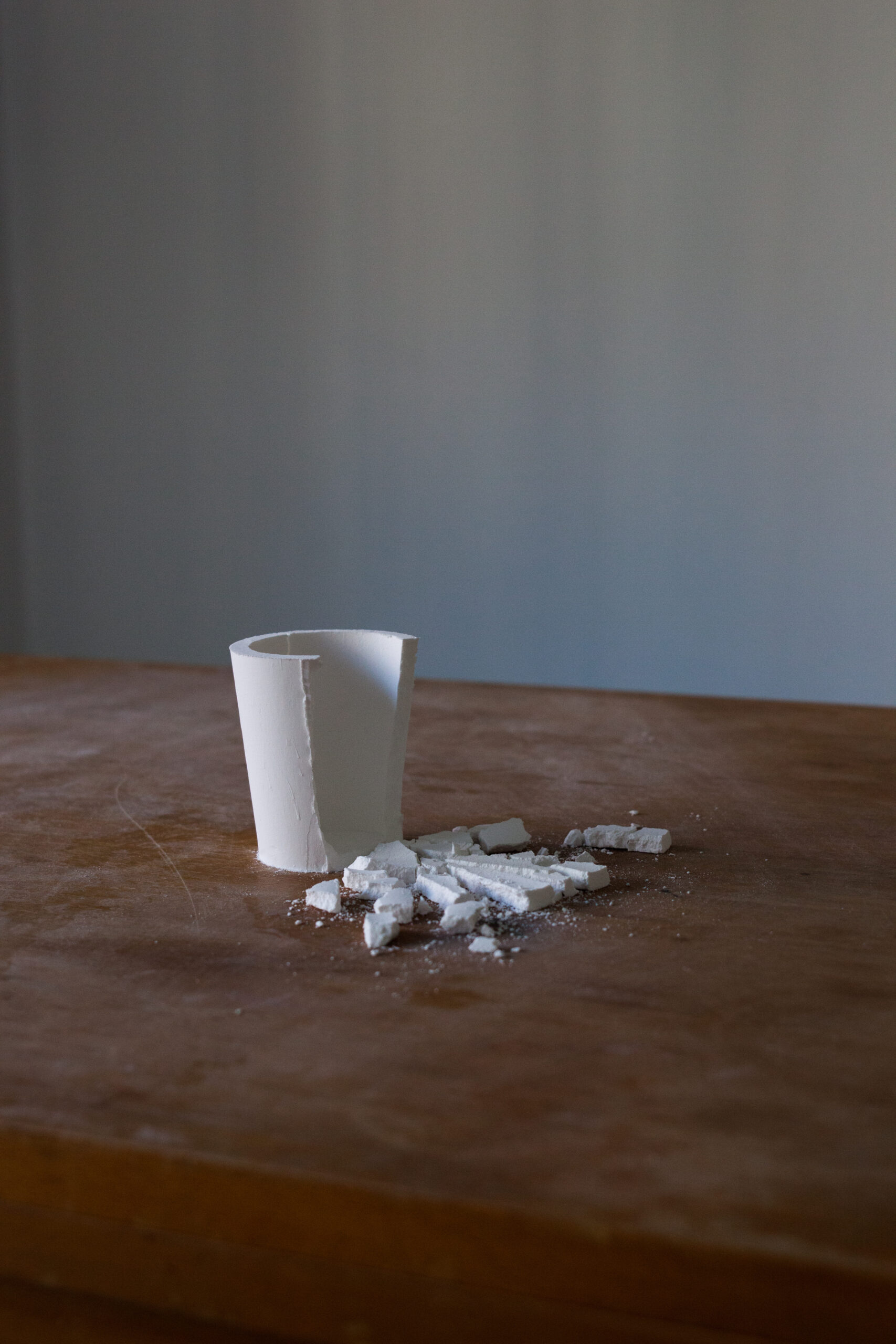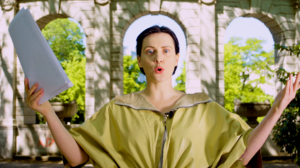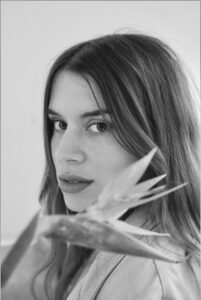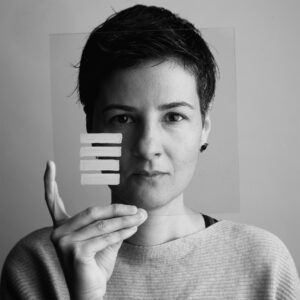Dana Tomečková

– born in 1986 in Bratislava – is a graduate of the jewellery program at the Academy of Fine Arts and Design in Bratislava. During her studies, she completed an exchange at the Oslo National Academy of the Arts. Before that, she graduated from the mass media and marketing communication studies at the Constantine the Philosopher University in Nitra and completed an exchange at the University of Copenhagen. She participated in several residencies in Slovakia and abroad, e.g. in the Cité des Arts in Paris, the FKSE residency in Budapest, or at the Schaubmar Mill in Pezinok.
I am interested in the permanence and inevitability with which matter transforms over time, I am interested in life and the inner workings of materials, in objects, us. I think my reaction to this incessant transformation is slowness and perseverance. And also care – as in taking care of something that is unsustainable, and searching for a way to touch it, to hold the time of existence. It also brings me questions of effort and usefulness – attention towards something that does not have an everlasting value.
I like the formability of materials like sugar, earth, pigment; the seeming impossibility to hold them in a shape, yet manage to do it, at least for a moment, until it falls, cracks, disappears. There is a fragility and vulnerability in these materials, and this inspires the careful attention they require when I work with them. In some ways they have a will of their own – even when I think I know them already, they surprise me when they do their own thing. I like their firmness that develops over time. And then the firmness that I create with touch, resistance. And also the transience – I like that at the end of the show I put them in a bag, and at the next opportunity they become something new. Working with them helps me understand the impermanence of any material, even one that we consider solid or durable because its life is longer than ours.
My approach to creative work was influenced by my study exchange in Oslo. At the university, I had access to state-of-the-art-equipment: microscopes, casting machines, printers, milling cutters, lathes… and, in my dissertation, I ended up using an iron and a plastic bag. It gave me greater clarity on everything I could do and all the directions I could take, but I do this.
Ideologically, I find myself close to phenomenology – for instance in the context of a person opening themselves towards the world and space – as well as eco-psychology. I relate these ideas to the exact sciences of physics and cosmology, which look at the space-time through its physical qualities such as density and tension.
I often ask: What does this space need? In other words, how best to support what is. I also draw on experience, and I give this experience a different, often larger, scale. For example, during the intervention with Peter Jánošík within Juraj Gábor’s Sphéra at the New Synagogue in Žilina, I processed an experience I had at the studio: the moment when a small jar of pigment fell out of my hand and its particles slowly settled on everything in the room. In that moment I found myself in a cloud of colour. I developed this experience through reflections about gravity, time, and the power of the Something that’s in the air.
In my free time I work mostly with common materials, and in jewellery, which I also practice, it seems I work with the complete opposite – precious metals. During the past three years, I have been developing the concept of Temporary matter, which somehow bridges these two positions of work. They connect through the reflection that all things are events, they happen in their own time and that time is of different lengths. That is why I think about a gold ring in the same way as I think about a sugar cube.
Today, I am much more picky than I used to be when creating the conditions for focus and for plunging into creative work. I have a longer ‘starting time’, but when I dive in, I enjoy it very much – timelessness, presence and alertness towards one single thing. This was preceded by several events, one of them was leaving my job. I awoke when looking through a barred window onto a courtyard made of concrete. I thought: “I can be here for another twenty years or don’t need to be here at all, and I feel the same about both of the options.” That was when I applied to the Academy of Fine Arts and Design in Bratislava. After university, together with some friends and colleagues, I founded Ovál – a studio focused on jewellery and sculpture. I was aided by a personal trauma and the act of dealing with the experience. With this came the feeling of fearlessness, of new space, depth, as well as an awareness of responsibility for my time.
I have various rituals – rituals of beginning, for instance: when I arrive at a new place I always clean the floor and the windows. I have a long ‘dance’ ritual at the studio. I prepare for work by circling around it: I water some plants, I rearrange some found items into new constellations, I remove and stick a note onto a different place, I look for a new home for things around me. I constantly have the need to create the space around me anew. I write and draw on many small pieces of paper, which I place on the desk. It looks a little like a tarot reading, I’m moving the cards around, searching for their relationships. I would like to be better at rituals of ending though; when I would say: ‘That’s that today’.
I am aware how much my point of view is shaped by the fact that I am a woman, a daughter, the smaller of two siblings, raised in a patriarchal environment. I think of it as a process – to look for my place by respecting my own time, and the quality of my ‘power’. I recognise that my work is associated with softness, ephemerality. From this springs, or used to spring, my need for resolution, for a higher speed – some sort of an effort to make up for the soft sensitivity and to have a stronger voice, in my work as well as in life. Like when you slam a fist on the table. But I am realising my power is a soft power.
When creating processual and partially also performative works, I generally like the approach of: you set some variables and into this enters the spectator or performer with their own package of experiences and perceptions. For example, my collaboration with Simona Gottierová and Martina Mäsiarová is not, generally speaking, aiming for a result or a fixed form, but is process-oriented. The shared experience of the search and the uncertainty is an authentic and acknowledged part, and the “result” is formed in collaboration with the viewer. In 1+1+1+1=1, a project for the Kiosk festival, we set instructions and invited the viewer (always only one at a time) into the space of an empty house containing subtle interventions. How they handled their time was individual, we only created the conditions and the playground/refuge.
Subsequently, when collaborating on the dance performance Diaries of Touch (choreography by Sonja Pregad), I came up with the design of the materials thanks to working with the performative potential they offer. A list was created – a kind of protocol for the space and the performers. What and when they chose from it was partly up to the choreographer, partly up to the performers, their intuition. I worked similarly in The End of Greatness, when, in collaboration with Vilma Braun, I compiled a notation of the options for the performers’ interaction with the pigmented objects. Into this situation entered the viewers, who had the opportunity to “immerse” themselves in the pigment and in the dialogue with the performers.
The text was written in collaboration with Miroslava Urbanová (2022).
1Image: Territory / Metaphorical Space, site-specific installation, sugar powder, 2017, photo: Ondrej Urban.
– sa narodila v roku 1986 v Bratislave – je absolventkou šperku na Vysokej škole výtvarných umení v Bratislave. Počas štúdia absolvovala študijný pobyt na Oslo National Academy of the Arts. Predtým absolvovala štúdium masmediálnej a marketingovej komunikácie na Univerzite Konštantína Filozofa v Nitre a študijný pobyt na University of Copenhagen. Zúčastnila sa na viacerých rezidenciách na Slovensku a v zahraničí, napr. v Cité des Arts v Paríži, rezidencie FKSE v Budapešti, či v Schaubmarovom mlyne v Pezinku.
Zaujíma ma neustálosť a neodvratnosť s akou sa hmota premieňa v čase, život a vnútorné procesy materiálov, objektov, nás. Myslím, že mojou reakciou na túto neustálu premenu je pomalosť a vytrvalosť. A tiež starostlivosť – o niečo, čo je neudržateľné, a hľadanie spôsobu, ako sa toho dotknúť, podržať čas existencie. Prináša mi to tiež otázky úsilia a užitočnosti – pozornosti pre niečo, čo nemá trvalú hodnotu.
Páči sa mi tvárnosť materiálov ako cukor, zemina, pigment, zdanlivá nemožnosť podržať ich v nejakom tvare – a predsa to urobiť, aspoň na chvíľu, kým to spadne, pukne, zmizne. Tieto materiály majú v sebe krehkosť a zraniteľnosť a z toho plynie veľká pozornosť, ktorú si pri práci odo mňa vyžadujú. Majú v niečom svoju vôľu – aj keď si myslím, že už ich poznám, vedia ma prekvapiť, keď si urobia svoje. Mám rada ich pevnosť, ktorá vznikne časom. A pevnosť, ktorú vytvorím ja dotykom, protitlakom. A ešte dočasnosť – na konci výstavy ich nasypem do tašky a pri ďalšej príležitosti sa stanú niečím iným. Práca s nimi mi pomáha chápať nestálosť akéhokoľvek materiálu, aj takého, ktorý považujeme za pevný či trvácny, pretože jeho život je dlhší ako náš.
Môj prístup k tvorbe ovplyvnil študijný pobyt v Osle. Mala som vtedy na škole k dispozícii najšpičkovejšie technologické vybavenie: mikroskopy, odlievačky, tlačiarne, frézy, sústruhy… a ja som nakoniec robila diplomovku so žehličkou a s igelitkou. Dalo mi to väčšiu jasnosť v tom, čo všetko by som mohla robiť a na akými smermi sa uberať, ale robím Toto.
Ideovo mám blízko k fenomenológii (napríklad otváranie sa človeka voči svetu/ priestoru) a tiež k eko-psychológii. Tieto myšlienky dávam do vzťahu s exaktnými vedami – fyzikou a kozmológiou, ktoré nazerajú na (časo)priestor cez jeho fyzické kvality akými sú hustota či napätie.
Často sa pýtam: Čo potrebuje tento priestor? Čiže ako čo najlepšie podporiť to, čo je.
Vychádzam tiež zo zažitého a dávam tejto skúsenosti inú, často väčšiu mierku. Napríklad pri intervencii s Petrom Jánošíkom do Sphéry Juraja Gábora v Novej Synogóge v Žiline som spracovala môj zážitok z ateliéru, moment, keď mi vypadla z ruky malá dóza s pigmentom a jeho čiastočky pomaly dosadali na všetko v miestnosti. Ocitla som sa vtedy v oblaku farby. Túto skúsenosť som rozvíjala cez úvahy o gravitácii, čase, a o sile Niečoho, čo je vo vzduchu.
Vo voľnej tvorbe pracujem prevažne so sypkými materiálmi, v šperku, ktorému sa tiež venujem, zdanlivo s úplným opozitom – s drahými kovmi. V priebehu uplynulých troch rokov som rozvíjala tému Dočasná hmota, ktorá v niečom premosťuje tieto dve polohy práce. Spája sa v úvahe o tom, že všetky veci sú udalosti, majú svoj čas a ten je rôzne dlhý. Preto aj o zlatom prsteni rozmýšľam v podobných rámcoch ako o cukrovej kocke.
Dnes si oveľa vedomejšie vytváram podmienky na koncentráciu a ponor do tvorby ako v minulosti. Mám dlhší „nástupný čas“, no keď sa ponorím, tak si to užívam – bezčasie, prítomnosť a bdelosť pri jednej jedinej veci. Predchádzalo tomu viac okolností, jednou bol odchod z práce. Precitla som pri pohľade cez zamrežované okno do vybetónovaného dvora – pomyslela som si vtedy: „Môžem tu byť ďalších dvadsať rokov alebo tu nemusím byť vôbec a ohľadom oboch možností sa cítim rovnako.“ Vtedy som sa prihlásila na Vysokú školu výtvarných umení v Bratislave. Po škole som založila s kamarátkami a kolegyňami ateliér Ovál zameraný na šperk a objekt. Pomohla mi k tomu osobná trauma a vyrovnávanie sa s ňou. S tým prišiel pocit, že už sa nemám čoho báť, pocit nového priestoru, hĺbky a aj zodpovednosti za môj čas.
Mám rôzne rituály, napr. rituály začiatku: umyť podlahu a okná, keď prídem na nové miesto. V ateliéri mám dlhý „tanečný“ rituál, pripravujem sa na prácu tak, že krúžim okolo nej: tu polejem kvety, tam preskupím nájdené predmety na poličke do nových konštelácií, prelepím papierik s poznámkou na iné miesto, hľadám veciam okolo nové miesto. Stále mám potrebu robiť si okolo seba priestor nanovo. Píšem a kreslím na veľa malých papierov a tie potom rozložím na stole. Vyzerá to trochu ako výklad tarotových kariet, ktoré presúvam a hľadám medzi nimi vzťahy. Chcela by som však byť lepšia v rituáli ukončovania. Keď si poviem: „Na dnes takto.“
Uvedomujem si ako môj pohľad formuje to, že som žena, dcéra, mladšie z dvoch detí, vychovaná v patriarchálnom prostredí. Beriem to ako proces, hľadať svoje miesto tak, že beriem ohľad na môj vlastný čas, a na to, aká je kvalita mojej „sily“. Vnímam, že moja práca je spájaná s jemnosťou, efemérnosťou. Z toho pramení (alebo pramenila) moja potreba ráznosti a väčšej rýchlosti, akási snaha dorovnávať jemnocit a mať silnejší hlas v tvorbe a v živote. Ako keď tresneš päsťou po stole. Ale prichádzam na to, že moja sila je mäkká sila.
Pri vytváraní procesuálnych a čiastočne i performatívnych diel mi je celkovo blízky prístup – ty nastavíš niektoré premenné a do toho vstupuje divák/čka, či performer/ka so svojím balíčkom skúseností a prežívania. Napríklad moja spolupráca so Simonou Gottierovou a Martinou Mäsiarovou celkovo nesmeruje k výsledku alebo ustálenej forme, ale je orientovaná na proces. Spoločné hľadanie a neistota je autentickou a priznanou súčasťou a „výsledok“ sa formuje v spolupráci s divákom. V projekte 1+1+1+1=1 pre festival Kiosk sme udelili inštrukcie a pozvali diváka/čku (vždy iba jedného) do priestoru prázdneho domu so subtílnymi intervenciami. Ako naložil/a so svojím časom bolo individuálne, my sme vytvorili podmienky a ihrisko/ útočisko.
Pri spolupráci na tanečnom predstavení Diaries of Touch (choreografia: Sonja Pregad) som zas prišla s návrhom materiálov, pracujúc s performatívnym potenciálom, ktorý ponúkajú. Vznikol zoznam, akýsi protokol pre priestor a performerov/ky. To, čo a kedy z neho vyberú bolo čiastočne na choreografke, čiastočne na performujúcich, ich nacítení. Podobne som postupovala aj v práci The End of Greatness, kedy som v spolupráci s Vilmou Braun zostavila zápis možností performerov/iek pre interakciu s pigmentovými objektami. Do tejto situácie vchádzali diváci a diváčky, ktorí mali možnosť „ponoriť sa“ do pigmentu a do dialógu s performujúcimi.
Text bol napísaný v spolupráci s Miroslavou Urbanovou (2022).
1Obrázok: Territory / Metaphorical Space, site-specific inštalácia, práškový cukor, 2017, foto: Ondrej Urban.


